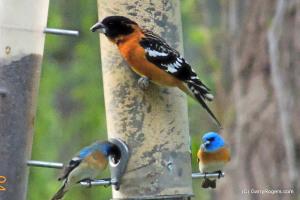GR: Birds and other wildlife are declining because of these human activities:
- habitat destruction (building and farming)
- resource harvests (logging, livestock grazing, and water diversion)
- habitat deterioration caused by introduced invasive plants
- habitat poisoning with pesticides and toxic wastes

Black-headed Grosbeaks aren’t as large as Robins, but they are big enough to have trouble perching on bird feeders. Young birds flutter and flap as they learn to use the feeder; occasionally you will see one hanging upside down from the feeder perch, it’s embarrassed blush hidden beneath its fine new feathers. Grosbeaks eat berries and insects, but their large beaks are especially effective with seeds. Their song is a rich warble similar to a robin’s but softer and sweeter (Photo: Male Black-headed Grosbeak above and Lazuli Buntings below by GR).
Numerous issues are present in each of these four topics. For instance, the sounds of our construction machinery is harmful to birds. In the article below, Sally Perkins discusses the hazard that windows create, and offers some solutions.
“It’s our responsibility to take care of all animals on this planet, to protect them from harm and keep them from extinction. With that in mind, we need to pay a little more attention to the windows we’re installing both on high-rise buildings and in our homes. Astonishingly, around 1,000,000,000 birds are killed every year in the United States as they unwittingly fly into the windows of our man-made structures.
Despite the fact that not all birds are killed on impact, a large number of them eventually perish regardless; a devastating result of the internal damage, bleeding and brain trauma caused by the initial collision. The fear is that a number of species, such as the Wood Thrush, Painted Bunting, Warbler, Kentucky Warbler and the Worm-eating Warbler are at risk of becoming extinct if the problem persists.
The good news, however, is that there are a number of materials and tricks we can employ to alert birds to the oncoming danger of a transparent or reflective surface, some of which are listed below.
- 1. Angled Glass
- 2. Fritted Glass
- 3. Etched or Sandblasted Glass
- 4. UV-reflective Glass
- 5. Decals and wind chimes
- 6. External shutters, including Venetian blinds
- 7. Tape Strips
- 8. All-season bug screens
- 9. External shades and awnings
- 10. The whitewashing of unused windows

